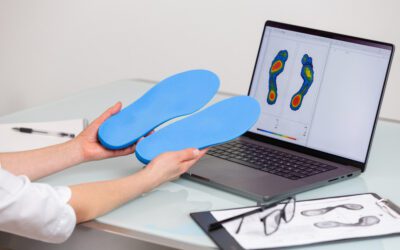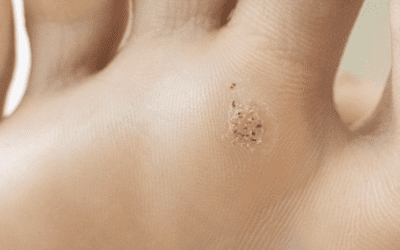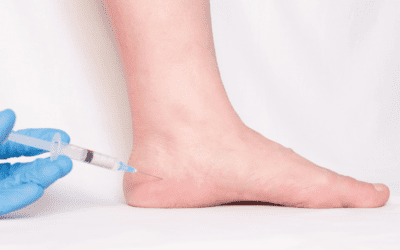For centuries, foot orthotics have evolved, going from simple inserts to custom-made devices precisely designed to treat various foot ailments.
This rich history attests to the constant improvement of materials, techniques, and the understanding of the biomechanics of the foot over time. However, the choice of orthotics does not depend solely on size or history. It is crucial to take into account factors such as materials, flexibility, level of support, and the type of shoe in which they will be worn to ensure the best comfort and effectiveness.
Foot orthotics are custom-made devices designed to fit an individual’s feet. Their primary goal is to realign the anatomical structures of the foot, provide comfort, and prevent or treat various pains and disorders. Treatment with orthotics can be remarkably effective in managing different foot conditions, such as flat foot or plantar fasciitis.
However, like any medical intervention, foot orthotics have both advantages and disadvantages. They offer undeniable benefits such as arch support and improved gait, but they may require a period of adaptation or adjustments. Moreover, other interventions, like surgery or physiotherapy, are also possible alternatives depending on the individual needs of the patient, this is always a decision that must be made after thorough evaluation.
The role of the podiatrist in the biomechanical evaluation of the feet is paramount. In a podiatric clinic, he uses specific techniques to identify problems and prescribe the appropriate type of foot orthotic. This stage of the evaluation is essential in Quebec and elsewhere, where healthcare services incorporate this approach in the management of foot pains.
Thorough Assessment by the Podiatrist
The podiatrist undertakes a rigorous biomechanical evaluation to deeply analyze an individual’s foot and gait. This analysis is crucial for diagnosing conditions such as flat foot or plantar fasciitis. In Quebec, in particular, this evaluation serves as the basis for creating customized orthotics, integrated within healthcare services.
The Different Types of Foot Orthotics
In the vast field of podiatric health, the variety of foot orthotics attests to the complexity and uniqueness of the foot problems encountered. Custom-made orthotics, designed to perfectly fit the patient’s feet, illustrate the commitment to personalized treatment. For those suffering from plantar fasciitis or heel spurs, special orthotics are made to alleviate these painful conditions. Athletes and active individuals can also benefit from sports orthotics, designed to provide additional support. The variety of types of foot orthotics ensures that every patient finds the necessary comfort and treatment.
What are the Foot Pains that Orthotics Can Relieve?
Foot pain is not just an annoyance; it can seriously affect the quality of life. Thanks to foot orthotics, a wide range of conditions can be treated. From complex problems like plantar fasciitis and heel spurs to misalignments such as bunions and flat feet, precisely measured orthotics bring indispensable relief. The lower limbs, often affected by foot misalignments, can also benefit from this intervention. The ability of orthotics to treat such a diverse range of pains underscores their importance in podiatric health.
How to Adapt Well to Wearing Foot Orthotics?
Adapting to wearing foot orthotics is a process that requires patience and attention. A gradual integration into the daily routine allows for a smooth transition. Combining orthotics with the appropriate shoes ensures not only comfort but also optimizes the effectiveness of the treatment. Regular follow-up with a podiatrist at the podiatric clinic offers the opportunity for necessary adjustments, ensuring that the orthotics continue to provide the required support.
How to Maintain Them Properly?
Like any medical device, foot orthotics require careful maintenance. Regular cleaning with specific products ensures their hygiene, while paying particular attention to their exposure to extreme temperatures prolongs their lifespan. Regular inspection also allows for detecting any signs of wear or damage, ensuring that the orthotics function at their maximum potential.
The role of the podiatrist does not end with prescribing an orthotic. Educating and raising awareness of the patient about its use, maintenance, and adaptation is paramount. Transparent communication between the professional and the patient is the key to successful treatment.
What are the Manufacturing Steps?
The manufacturing of foot orthotics is a meticulous and precise process that begins with a thorough biomechanical evaluation.
This crucial step allows for a detailed understanding of the patient’s gait and foot structure, the measurement taking, often assisted by technology, follows, allowing for precise design. The manufacturing phase integrates this information to create orthotics adapted to specific needs.
Finally, hand finishing and adjustment ensure that the orthotics are ready to provide the necessary comfort and support. The complete process illustrates the commitment to quality and individualization, which are at the heart of podiatric practice.
Technological advances have revolutionized the manufacturing of foot orthotics, allowing for high-precision customized products. The quality of the materials used, coupled with these innovations, ensures both comfortable and durable orthotics.
The advent of digital technologies has also impacted the field of orthotics. Innovations such as 3D printing offer unprecedented customization, while the emergence of new materials guarantees durability and comfort. But while technology makes these devices more accessible and effective, it is also important to consider their cost. Fortunately, many insurance and health programs recognize their value, offering partial or full reimbursements to ease the financial burden on patients.
Foot Orthotics Q and A
Q: Why should we pay attention to our feet?
A: Feet play a crucial role in our daily well-being. A variety of pains can arise as a result of misalignment or a specific condition, impacting our ability to function normally.
Q: What is a foot orthotic?
A: Foot orthotics are custom-made devices designed to fit an individual’s feet. Their purpose is to realign the anatomical structures of the foot, provide comfort, and prevent or treat various disorders and pains.
Q: How does a podiatrist contribute to the use of foot orthotics?
A: The podiatrist plays a pivotal role in the biomechanical assessment of the feet. They use specific techniques to identify problems and prescribe the appropriate type of foot orthotic.
Q: What are the main types of foot orthotics?
A: There are various types of orthotics to address specific issues. These include custom-made orthotics, orthotics for plantar fasciitis or heel spurs, and sports orthotics for athletes.
Q: How can foot orthotics help with foot pain?
A: Orthotics treat a wide range of conditions, ranging from plantar fasciitis and heel spurs to misalignments such as hallux valgus and flat feet. They bring relief and can also benefit other parts of the lower limbs.
Q: How to adapt to wearing foot orthotics?
A: It requires a gradual integration into the daily routine, combined with appropriate footwear. Regular follow-up with a podiatrist is also recommended to ensure their effectiveness.
Q: How to maintain foot orthotics?
A: It is crucial to clean them regularly with specific products and to avoid exposing them to extreme temperatures. Regular inspection allows for the detection of wear signs.
Q: What is the manufacturing process of foot orthotics?
A: The manufacturing begins with a thorough biomechanical evaluation of the foot, followed by taking measurements. After that, the orthotics are custom-made according to the patient’s needs, then adjusted and finished by hand.
Q: How has modern technology influenced the field of foot orthotics?
A: Digital technologies, like 3D printing, have brought unprecedented customization, while the emergence of new materials ensures durability and comfort.
Q: What are the advantages and disadvantages of foot orthotics?
A: Orthotics offer benefits such as arch support and improved gait. However, they may require an adaptation period and adjustments. Other interventions, like surgery or physiotherapy, may be considered depending on the patient’s needs.
Q: How do insurances and health programs support the use of foot orthotics?
A: Many insurances and health programs recognize the value of foot orthotics, offering partial or full reimbursements to financially assist patients.
Q: Why is an initial consultation with an expert important before choosing orthotics?
A: A first visit to the podiatrist allows for the accurate assessment of the patient’s specific needs. Working closely with an expert guarantees a successful treatment tailored to each individual case.



